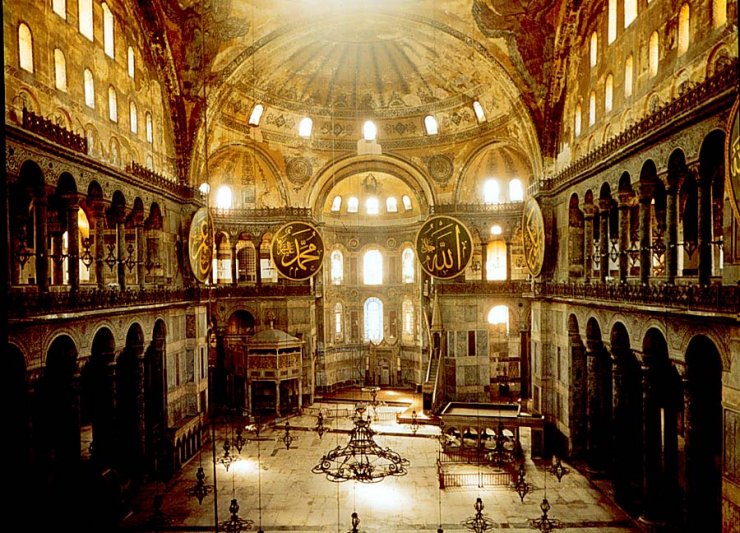This architectural masterpiece has had a profound influence on Christian and Islamic architecture. For 1400 years, the mighty dome of Hagia Sophia – the words mean ‘holy wisdom’ in Greek – dominated the spiritual life of the city of Constantinople (the present-day Istanbul). This massive construction of main dome semi-domes, buttresses and outbuildings is offset by four elegant minarets, one at each corner, for Hagia Sophia was conceived and built as a Christian church, then converted by one of the world’s most gifted architects to serve as an Islamic mosque.Constantinople, capital of the Byzantine Empire, took up the mantle of guardianship of classical civilization after the sacking of Rome by the Visigoths in AD 410. Successive emperors determined that the city – poised at the cross-roads between Europe and Asia, on the Bosporus – should be the religious, artistic and commercial capital of the world. In AD 532 the Emperor Justinian, renowned for his many ambitious construction programmes, commissioned the great church of Hagia Sophia.
No one had attempted to build such a large church before. Justinian chose as his architects two Greek mathematicians, Anthemius of Talles and Isidorus of Miletus, in the belief that only men trained in mathematics would be able to calculate the curves and angles required in the domes, to assess the strains and stresses involved and to decide where to place buttresses and supports. Justinian imported beautiful materials from all over the empire, from Greece and Rome, Turkey and North Africa. An army of 10,000 sculptors, masons, carpenters and mosaicists took five years to fashion red and green porphyry, yellow and white marble, and gleaming gold and silver into the most magnificent church in Christendom.

Justinian is reputed to have exclaimed, upon entering Hagia Sophia, “O Solomon, I have surpassed thee”! The interior is a masterpiece of light and space: a smooth marble floor; walls faced with glistening mosaics and panels of marble; deeply cut marble columns of so many hues that the contemporary historian Procopius likened them to a meadow full of flowers in bloom. Resplendent above these treasures is the dome, some 100ft (30m) in diameter, constructed using special bricks imported from the Greek island of Rhodes. Forty ribs extend from its centre to its base, which is cut by 40 windows like a crown studded by diamonds of light. Around the dome, to help spread and support its load in addition to overcoming the problem of how to sit a circular cupola on a square base, the architects devised smaller half-domes, beyond which are even smaller half-domes. The spaces between these were filled with elaborate plasterwork, then both dome and ceiling were covered in gold to reflect every polished surface of the interior.

Hagia Sophia was the centre of the eastern Christian world for almost 1000 years, but it was beset by problems from the start. Only 21 years after its completion it was damaged by an earth tremor and had to be partially rebuilt. Gradually its riches were plundered. In 1204 soldiers of the Fourth Crusade on their way to Jerusalem and hostile to the Eastern Orthodox Church (the formal split between the churches of Rome and Constantinople had been acknowledged in 1054) stripped the interior of the building. The last Christian service was held on the evening of 28th May 1453, when Emperor Constantine XI, tears in his eyes, took communion there. Although only a few hours later the Ottoman Turks stormed the city’s walls, their commander Mehmet II expressly forbade his troops to desecrate the church.
Hagia Sophia was converted into a mosque in the 16th century under the direction of Siman Pasha (1489-1588), one of the Islamic world’s greatest architects, whose masterpieces include Topkapi palace and the mosques he built for the emperors Suleiman the Magnificent and Selim II. In accordance with Islamic tradition, Sinan painted over most of the representational frescoes and mosaics, replacing them with discs bearing texts from the Koran, and removed any remaining Christian statues.
In 1934 Hagia Sophia was stripped of any religious significance and is today a museum. To the many visitors drawn here each year, however, I remains a spiritual oasis in a bustling metropolis. And, although the interior is bare, its spatial magnificence is undiminished. In its cool marble floors, elegant columns and great dome rising towards the heavens, Hagia Sophia retains something of Justinian’s vision.



































